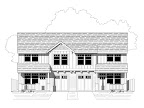For the past week plus we've watched the nation of Haiti fall apart after an earthquake. Reading stories and seeing the images makes us very disappointed that we can't just up and go to help. But what would we do? We have no medical experience. We could help distribute supplies, I suppose. But since our passion is architecture, our thoughts leaned that way. Many people have lost their homes to the 7.0 rumbler. Even the presidential palace is destroyed (as in structurally unsound, not rubble on the ground).
Why did the homes fail? Mostly because of the poor building practices. A good number of homes are concrete with less than adequate mix and not necessarily any rebar. Concrete has the distinction of being inflexible. If you stress it, concrete does not bend, it cracks and breaks. Bad for homes.
So we gave some thought to how we could help the residents of Port-au-Prince. We thought about buying them some rebar, but shipping costs would be a bit high. We thought about designing some prefab homes ala Michael Janzen, but he's got a great product already and lumber is not exactly plentiful on the island.
So then we ran across some blog entries on earthbag homes. What is that, pray tell? Take a bag, fill it with dirt, stack, repeat. Easy. You can check out a Haitian Dirtbag home here that withstood the quake just fine. The owner of this home, Father Theo, cares for orphans in Haiti and runs a blog here. Their other concrete buildings sustained some minor damage. Think this might be a fluke? Check out some earthbag testing here.
"So what?" you might say. "This all looks fine. Are you going to go to Haiti and build earthbag homes?" Not quite. But we believe Father Theo is on to something. Earthbag homes use local materials, can be built in a day, are sturdy, insulative, and cheap. We would like to lobby with Habitat for Humanity to consider rebuilding Port-au-Prince with earthbag homes to avoid any future apocalyptic aftermaths. Once we get that okay, we will begin donating a portion of our plan sales towards buying bags, barbed wire, and any other necessities to rehabilitate Haiti.
You can voice your opinion too by clicking here. Please write and tell them that you think earthbag homes would be the most sustainable housing stock for Haitian revival. May Haiti thrive.
Tuesday, January 19, 2010
Tuesday, January 5, 2010
Putting our Watts where our Mouth is
For a couple of years now Istockhouseplans has been talking all about energy efficiency and how you should be including it in the homes you build. We've talked about stud spacing, floor joist spacing, truss spacing, thicker walls, advanced framing, and modular design. We've given you plenty of advice (solicited and un-) about what we think the world should be like.
But unlike the doctor who discourages you from smoking and then asks for a light, we can back up our claims. As part of our partnership with Energy Trust of Oregon, we are having our plans energy modeled. We'll start with a base code score and then suggest a few improvements that would be the most suitable regarding energy efficiency and your wallet. If you decide you want to get a lot more creative in your build (R-30 walls?), we can run a preliminary score for you to see how much better your home would be.
We'll spend the next few months updating our portfolio with these numbers and then give you the results. While we don't expect usage numbers in the teens (70's-80's is average), we do expect that you'll be able to give your buyers a more complete picture of their new home. Just another service that Istockhouseplans offers.
But unlike the doctor who discourages you from smoking and then asks for a light, we can back up our claims. As part of our partnership with Energy Trust of Oregon, we are having our plans energy modeled. We'll start with a base code score and then suggest a few improvements that would be the most suitable regarding energy efficiency and your wallet. If you decide you want to get a lot more creative in your build (R-30 walls?), we can run a preliminary score for you to see how much better your home would be.
We'll spend the next few months updating our portfolio with these numbers and then give you the results. While we don't expect usage numbers in the teens (70's-80's is average), we do expect that you'll be able to give your buyers a more complete picture of their new home. Just another service that Istockhouseplans offers.
Subscribe to:
Posts (Atom)





